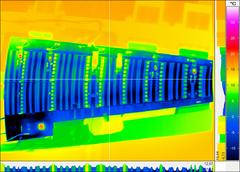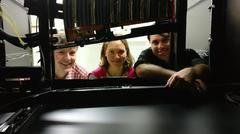With the help of an infrared camera, the scientists can check the efficiency of their new cooling system. Credit: DESY
Particle detectors like the huge ATLAS detector at CERN’s Large Hadron Collider have to be cooled all the time. When particles collide with each other and the electronic components and sensors of the detectors are working flat out, they generate a lot of heat, which poses a threat to the efficiency of those components and can in the worst case result in overheating. At DESY, a new carbon dioxide cooling has now been successfully tested.
For scientists, it is crucial to know with the utmost precision where and when a particle passed through the detector and how much energy it was carrying, in order to be able to reconstruct exactly what happened during the collision and whether any rare particles were involved. To achieve this, the detector needs to be “hermetic”; in other words, the sensors ought to completely enclose the collision point, leaving no “holes” or “blind spots”. Also, no obstructions such as cooling pipes or supports must get in the way of the particles. In other words, cooling needs to be as efficient as possible while using as little material as possible to do the job.
A major upgrade of the accelerator and the detectors is due to take place in about ten years. For the most central components of the ATLAS detector, the tracker, the scientists will be switching completely to silicon sensors, which are better able to cope with the higher collision rates and offer a higher resolution. They work best if they are cooled. The plan is to cool them using a ubiquitous compound, CO2 – carbon dioxide. Under conditions of high pressure and low temperature, this refrigerant is liquid rather than gaseous. However, its particularly efficient cooling effect is caused by the liquid evaporating and in doing so absorbing heat from the detector. “This efficient method of cooling, which has already been tested on a number of detector subsystems and which is to be used on a larger scale in future in many particle detectors, is called evaporative cooling,” explains Jan-Hendrik Arling, a PhD student in the DESY ATLAS Group.
DESY is playing a key role in developing and building the tracker for the intended upgrade. Thus one of the two end-caps – a part of the detector that closes off the concentric layers of the detector on either side and that is exposed to particularly large numbers of particles – is being assembled at DESY, for example. The cooling tests carried out on the new detector components also originated here. One of the first tests on a prototype has now revealed: everything’s cool.
“We are using the tests to find out how the temperature can be measured precisely, how hot our silicon sensors become and whether the sensors may even have a thermal memory,” explains Claire David, a researcher at DESY who is coordinating the test. “For us, the rule is: the colder the better. And we have managed to achieve that!”
To conduct the test, the scientists used a prototype of one part of the end-cap. This had been built for precisely this purpose, as a thermomechanical prototype, but in addition it will be used by many other research groups too. Because of this, great care had to be taken, since black adhesive strips had to be attached to the fragile silicon chips for this test, for example. Afterwards, the prototype was placed in a thermally isolated test chamber, cooled using a cooling unit borrowed from the International Linear Collider project, and photographed using an infrared heat camera. Among other things, the scientists also had to take into account the angle from which they photographed the prototype, because “silicon reflects any kind of heat, even the small amounts of heat produced by the camera. That would have disrupted our measurements,” says Claire David.
The collected data now needs to be analysed in more detail. At the end of the day, some 165 square metres of silicon strip detectors are to be operated in ATLAS using this CO2 evaporative cooling mechanism. Before that can happen, though, the scientists still have quite a bit of work to do.









